2004 CHEVROLET KODIAK child lock
[x] Cancel search: child lockPage 1 of 366

Seats and Restraint Systems........................... 1-1
Front Seats
............................................... 1-2
Rear Seats
............................................... 1-7
Safety Belts
.............................................. 1-8
Child Restraints
.......................................1-27
Air Bag System
.......................................1-48
Restraint System Check
............................1-61
Features and Controls..................................... 2-1
Keys
........................................................ 2-2
Doors and Locks
....................................... 2-6
Windows
.................................................. 2-8
Theft-Deterrent Systems
............................2-10
Starting and Operating Your Vehicle
...........2-11
Mirrors
....................................................2-39
Storage Areas
.........................................2-41
Instrument Panel............................................. 3-1
Instrument Panel Overview
.......................... 3-4
Climate Controls
......................................3-19
Warning Lights, Gages, and Indicators
........3-23
Audio System(s)
.......................................3-45
Driving Your Vehicle....................................... 4-1
Your Driving, the Road, and Your Vehicle
..... 4-2
Towing
...................................................4-31Service and Appearance Care.......................... 5-1
Service
..................................................... 5-3
Fuel
......................................................... 5-6
Checking Things Under the Hood
...............5-18
Rear Axle
...............................................5-61
Noise Control System
...............................5-62
Bulb Replacement
....................................5-63
Windshield Wiper Blade Replacement
.........5-63
Other Service Items
..................................5-64
Tires
......................................................5-68
Appearance Care
.....................................5-76
Vehicle Identification
.................................5-85
Electrical System
......................................5-86
Capacities and Specifications
.....................5-93
Normal Maintenance Replacement Parts
....5-100
Maintenance Schedule..................................... 6-1
Maintenance Schedule
................................ 6-2
Customer Assistance and Information.............. 7-1
Customer Assistance and Information
........... 7-2
Reporting Safety Defects
............................ 7-6
Index.................................................................1
2004 Chevrolet Kodiak Owner ManualM
Page 19 of 366
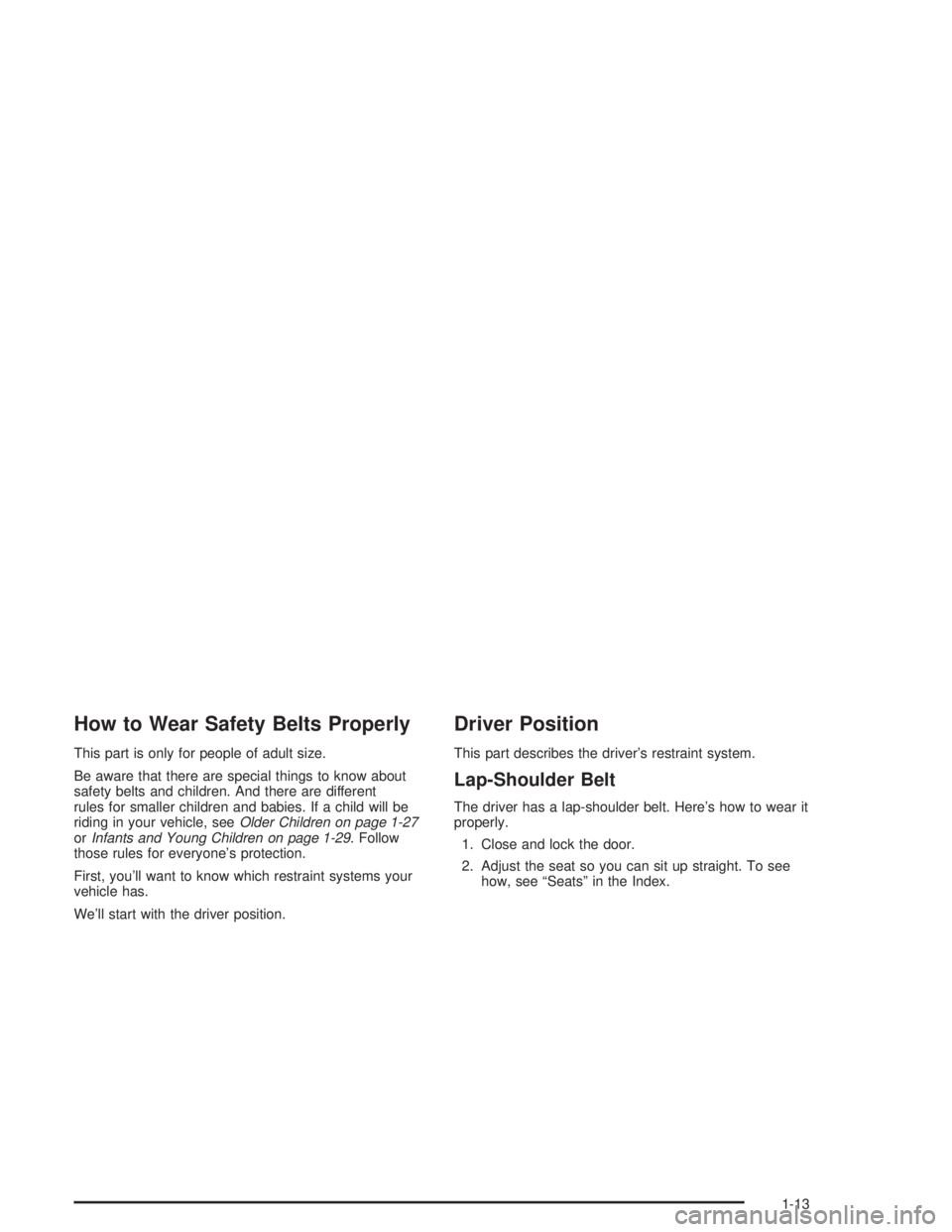
How to Wear Safety Belts Properly
This part is only for people of adult size.
Be aware that there are special things to know about
safety belts and children. And there are different
rules for smaller children and babies. If a child will be
riding in your vehicle, seeOlder Children on page 1-27
orInfants and Young Children on page 1-29. Follow
those rules for everyone’s protection.
First, you’ll want to know which restraint systems your
vehicle has.
We’ll start with the driver position.
Driver Position
This part describes the driver’s restraint system.
Lap-Shoulder Belt
The driver has a lap-shoulder belt. Here’s how to wear it
properly.
1. Close and lock the door.
2. Adjust the seat so you can sit up straight. To see
how, see “Seats” in the Index.
1-13
Page 28 of 366
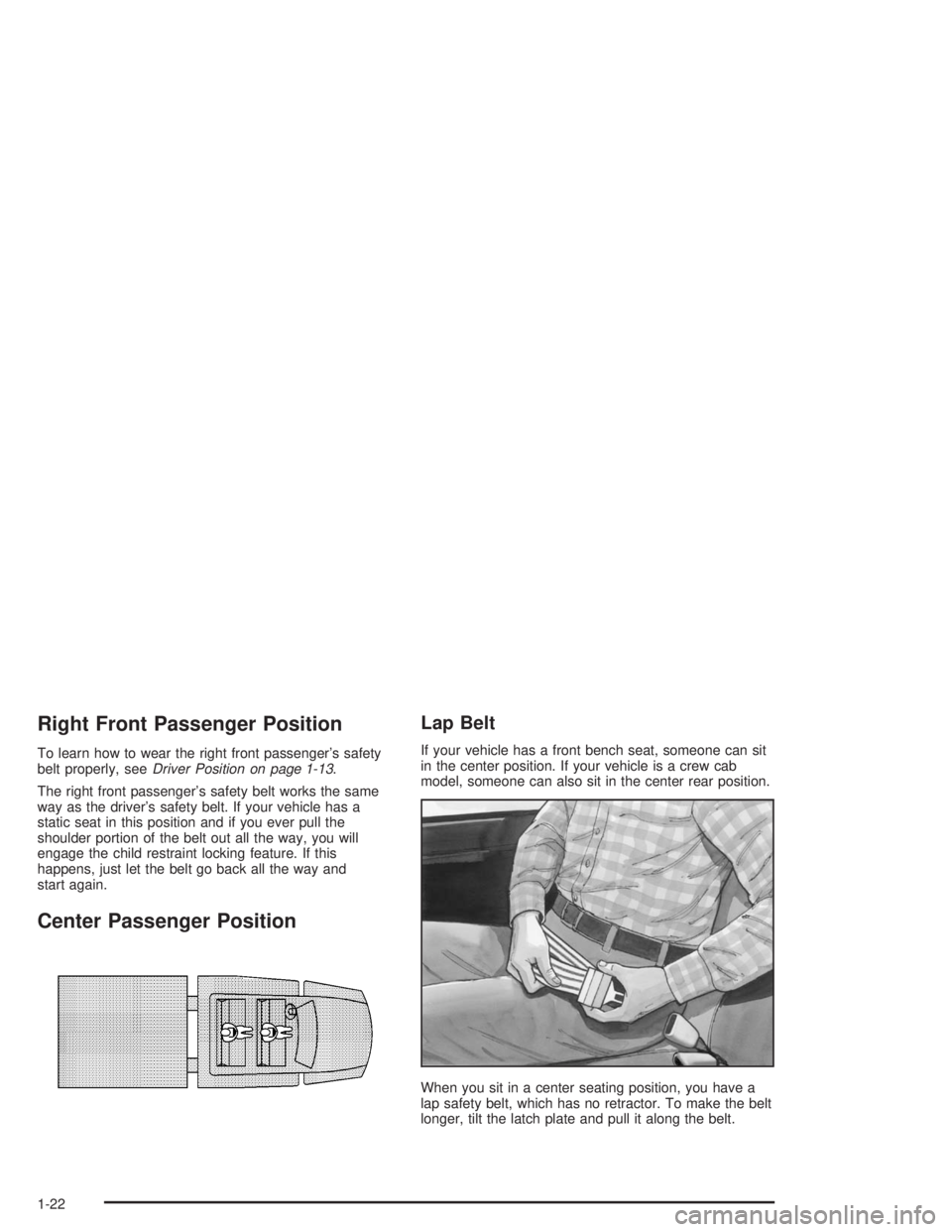
Right Front Passenger Position
To learn how to wear the right front passenger’s safety
belt properly, seeDriver Position on page 1-13.
The right front passenger’s safety belt works the same
way as the driver’s safety belt. If your vehicle has a
static seat in this position and if you ever pull the
shoulder portion of the belt out all the way, you will
engage the child restraint locking feature. If this
happens, just let the belt go back all the way and
start again.
Center Passenger Position
Lap Belt
If your vehicle has a front bench seat, someone can sit
in the center position. If your vehicle is a crew cab
model, someone can also sit in the center rear position.
When you sit in a center seating position, you have a
lap safety belt, which has no retractor. To make the belt
longer, tilt the latch plate and pull it along the belt.
1-22
Page 46 of 366
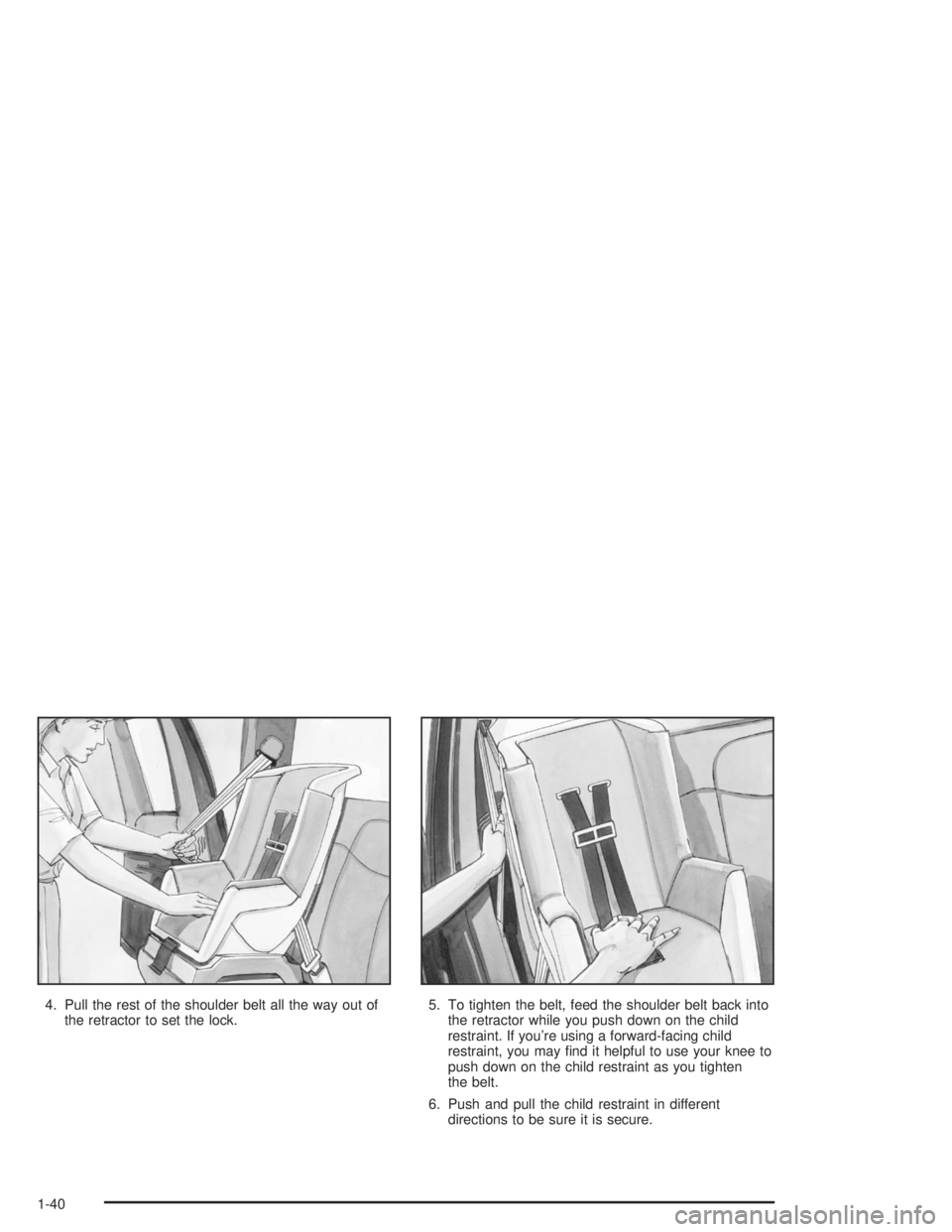
4. Pull the rest of the shoulder belt all the way out of
the retractor to set the lock.5. To tighten the belt, feed the shoulder belt back into
the retractor while you push down on the child
restraint. If you’re using a forward-facing child
restraint, you may find it helpful to use your knee to
push down on the child restraint as you tighten
the belt.
6. Push and pull the child restraint in different
directions to be sure it is secure.
1-40
Page 53 of 366
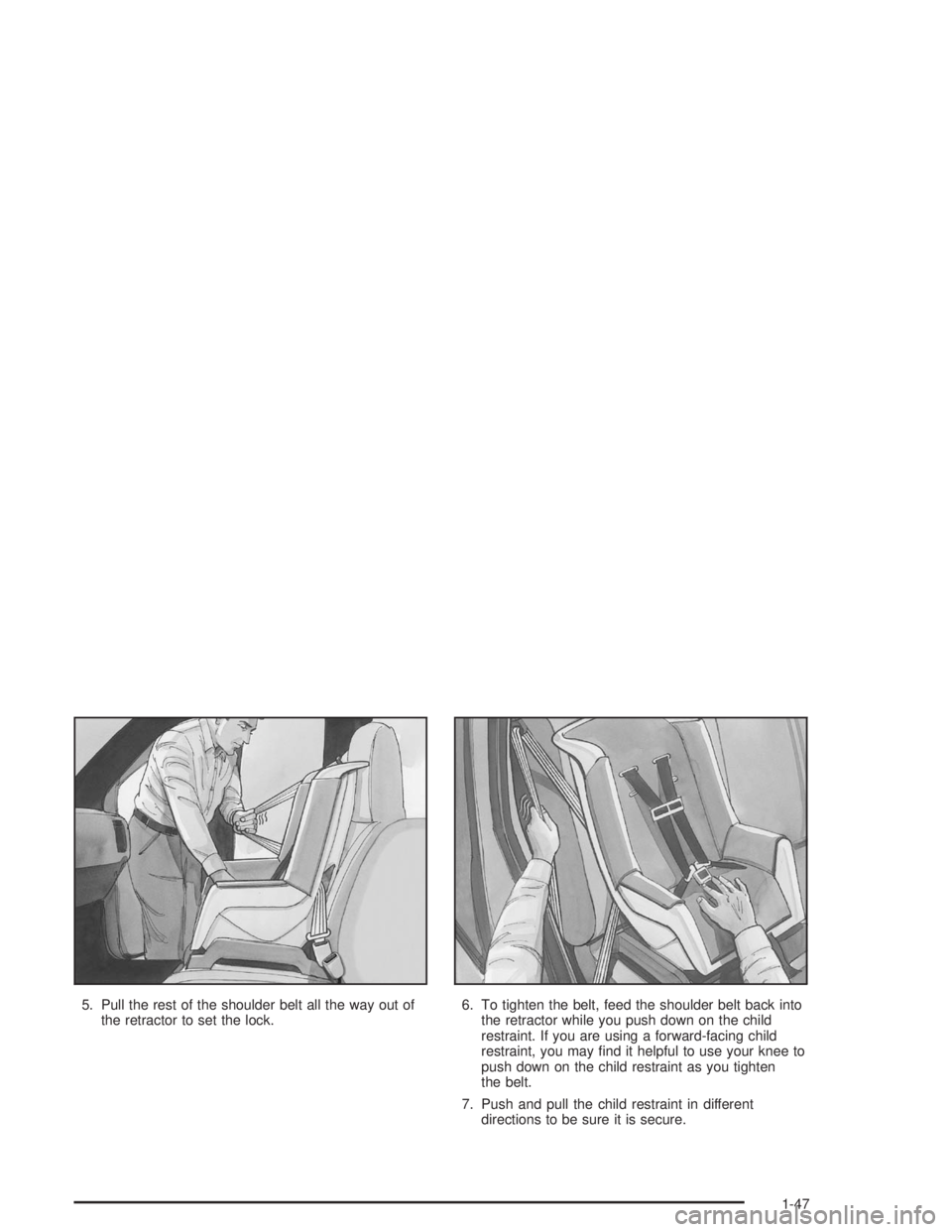
5. Pull the rest of the shoulder belt all the way out of
the retractor to set the lock.6. To tighten the belt, feed the shoulder belt back into
the retractor while you push down on the child
restraint. If you are using a forward-facing child
restraint, you may find it helpful to use your knee to
push down on the child restraint as you tighten
the belt.
7. Push and pull the child restraint in different
directions to be sure it is secure.
1-47
Page 74 of 366

Resynchronization
Resynchronization may be necessary due to the
security method used by this system. The transmitter
does not send the same signal twice to the receiver. The
receiver will not respond to a signal it has been sent
previously. This prevents anyone from recording
and playing back the signal from the transmitter.
To resynchronize your transmitter, stand close to your
vehicle and simultaneously press and hold the LOCK
and UNLOCK buttons on the transmitter for at least five
seconds. The door locks should cycle to confirm
resynchronization. If the locks do not cycle, see your
dealer for service.
Doors and Locks
Door Locks
{CAUTION:
Unlocked doors can be dangerous.
Passengers — especially children — can
easily open the doors and fall out of a
moving vehicle. When a door is locked, the
handle will not open it. You increase the
chance of being thrown out of the vehicle
in a crash if the doors are not locked. So,
wear safety belts properly and lock the
doors whenever you drive.
Young children who get into unlocked
vehicles may be unable to get out. A child
can be overcome by extreme heat and can
suffer permanent injuries or even death
from heat stroke. Always lock your vehicle
whenever you leave it.
Outsiders can easily enter through an
unlocked door when you slow down or
stop your vehicle. Locking your doors can
help prevent this from happening.
2-6
Page 183 of 366
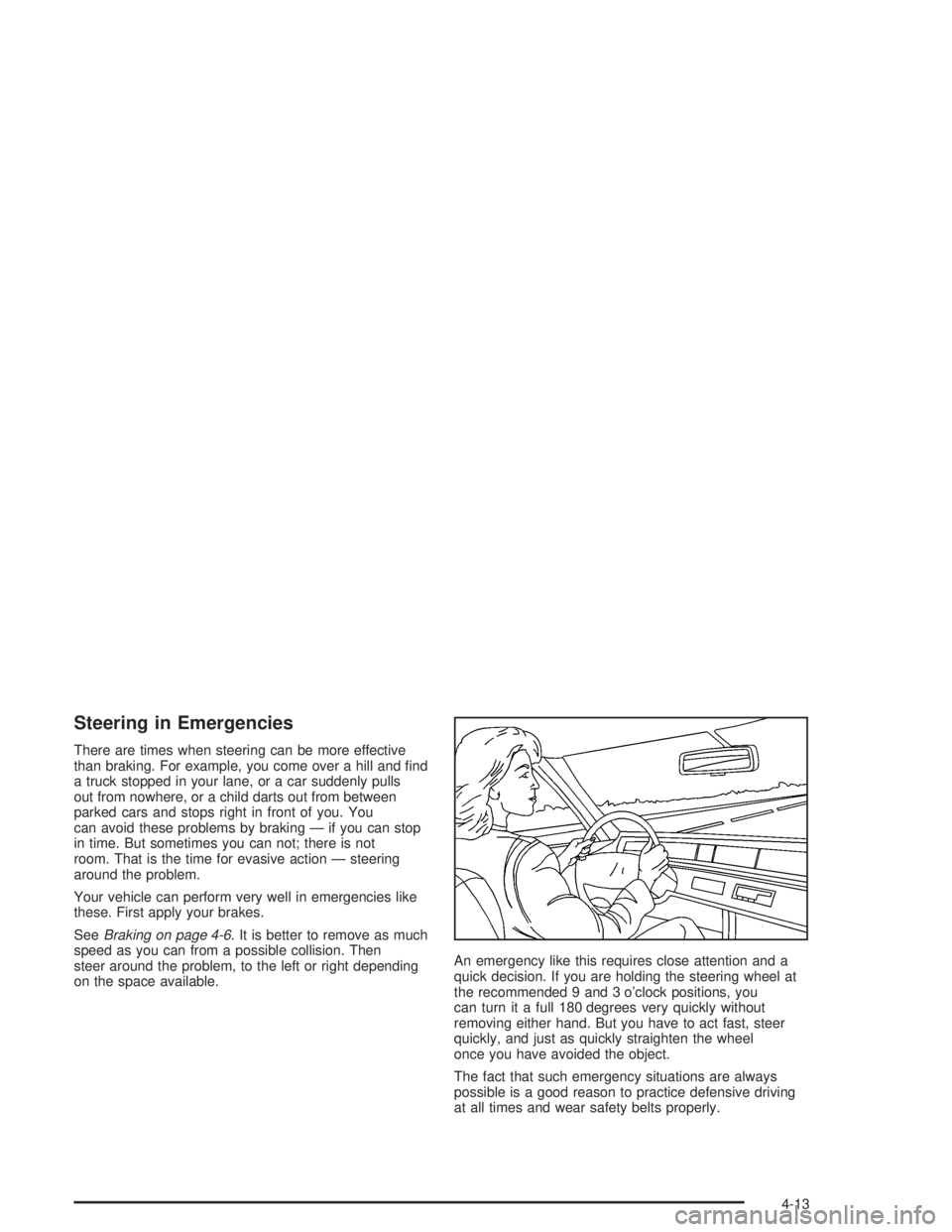
Steering in Emergencies
There are times when steering can be more effective
than braking. For example, you come over a hill and find
a truck stopped in your lane, or a car suddenly pulls
out from nowhere, or a child darts out from between
parked cars and stops right in front of you. You
can avoid these problems by braking — if you can stop
in time. But sometimes you can not; there is not
room. That is the time for evasive action — steering
around the problem.
Your vehicle can perform very well in emergencies like
these. First apply your brakes.
SeeBraking on page 4-6. It is better to remove as much
speed as you can from a possible collision. Then
steer around the problem, to the left or right depending
on the space available.An emergency like this requires close attention and a
quick decision. If you are holding the steering wheel at
the recommended 9 and 3 o’clock positions, you
can turn it a full 180 degrees very quickly without
removing either hand. But you have to act fast, steer
quickly, and just as quickly straighten the wheel
once you have avoided the object.
The fact that such emergency situations are always
possible is a good reason to practice defensive driving
at all times and wear safety belts properly.
4-13
Page 353 of 366

Care of
Safety Belts................................................5-79
Your Cassette Tape Player............................3-57
Your CD Player...........................................3-59
Your CDs ...................................................3-59
Cassette Tape Messages.................................3-52
CD Adapter Kits.............................................3-52
Center Console Storage Area...........................2-42
Center Passenger Position, Safety Belts.............1-22
Charging System Light....................................3-30
Chassis Lubrication.........................................5-51
Check
Engine Light...............................................3-37
Gages Warning Light...................................3-42
Checking Coolant............................................5-34
Checking Engine Oil................................5-21, 5-25
Checking Things Under the Hood......................5-18
Checking Your Restraint Systems......................1-61
Chemical Paint Spotting...................................5-83
Child Restraints
Child Restraint Systems...............................1-33
Infants and Young Children...........................1-29
Older Children.............................................1-27
Securing a Child Restraint in a Rear
Outside Seat Position...............................1-39
Securing a Child Restraint in the Center
Rear Seat Position (Crew Cab
®) or Center
Front Position..........................................1-41Child Restraints (cont.)
Securing a Child Restraint in the Right
Front Seat Position...................................1-43
Top Strap...................................................1-38
Where to Put the Restraint...................1-35, 1-37
Chime Level Adjustment..................................3-59
Chugger-Snubber Lock-Out Feature.................... 1-7
Cigarette Lighter.............................................3-18
Cleaning
Inside of Your Vehicle..................................5-77
Outside of Your Vehicle................................5-80
Underbody Maintenance...............................5-83
Weatherstrips..............................................5-79
Cleaning Exterior Lamps/Lenses.......................5-80
Cleaning Fabric/Carpet....................................5-77
Cleaning Glass Surfaces..................................5-79
Cleaning Interior Plastic Components.................5-79
Cleaning the Top of the
Instrument Panel.........................................5-79
Cleaning Vinyl................................................5-78
Climate Control System...................................3-19
Outlet Adjustment........................................3-22
Rear Heating System...................................3-23
Clutch Brake (Vehicles with Non-Synchronized
Transmission)..............................................2-32
Clutch Pedal Free Travel.................................5-51
Cold Weather Starting (Diesel Engine)...............2-20
Cold Weather Starting
(Caterpillar
®Diesel).....................................2-15
3